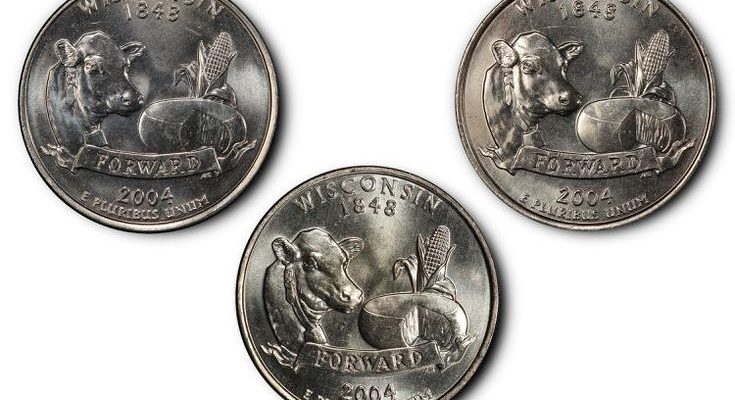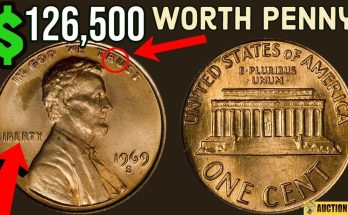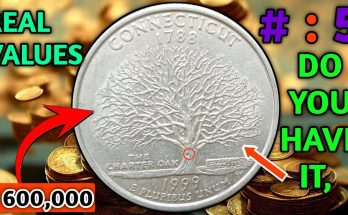The 50 State Quarters series debuted in 1999. Each year, five unique designs were used to honor each state in the order they joined the Union.
The United States Mint estimates that more than 140 million people collected the 50 State Quarters. In total, the mint manufactured over 35 billion state quarters. With that large of a mintage, the odds of error coins escaping the mint are relatively common. There are examples of die-filled strikes, such as the “In God We Rust” error and many off-center strikes that can be purchased for a few dollars from your favorite coin dealer. Some errors are more valuable, though.
The Wisconsin Quarter
In 2004, Wisconsin was honored as the twenty-ninth state to join the Union. The state’s quarter features a reverse with a cow on the left side and an ear of corn partially hidden behind the wheel of cheese on the right. A banner with the motto FORWARD flanks the bottom of the coin. The obverse of this quarter, and all coins in the state series, share a common design depicting President George Washington. But there were errors in some Wisconsin quarters that make them more valuable today than others.
The Wisconsin quarter’s design was adapted from a drawing by Wisconsin resident Rose Marty who lived on a farm in Monticello, Wisconsin. Mint sculptor-engraver Alfred F. Maletsky adopted the drawing for coinage. This artwork was his last project before he retired on December 31, 2003. The Mint officially released the coin to the general public on October 25, 2004.
Here are some Wisconsin quarter erros to keep an eye out for.
:max_bytes(150000):strip_icc():format(webp)/US0025-50-State-Quarter-2004-Wisconsin-Extra-Leaf-Low-lg-5c4a75c046e0fb0001900222.jpg)
2004-D Wisconsin State Quarter Die Variety
According to Q. David Bowers, on December 11, 2004, Bob Ford brought two quarters to the Old Pueblo Coin Exchange in Tucson, Arizona. Manager Ben Weinstein inspected the coins and determined they could be a possible die variety. Owner Rob Weiss purchased the coins from Ford and contacted Coin World magazine editor Bill Gibbs with the news of a new die variety.
By January 2005, word spread like wildfire, and the hunt was on across the United States, searching for these two new die varieties. The first variety looks like there is an extra leaf on the left side of the ear of corn very near the top leaf and is known as the “Extra Leaf High” variety. The second variety also has an extra leaf on the left side of the ear of corn but is lower and touches the wheel of cheese. This variety is known as the “Extra Leaf Low” variety.
:max_bytes(150000):strip_icc():format(webp)/US0025-50-State-Quarter-2004-Wisconsin-Extra-Leaf-High-lg-5c4a7581c9e77c0001803309.jpg)
How it Happened
In December 2005, die variety and error expert J. T. Stanton, author of the “Cherrypickers’ Guide to Rare Die Varieties,” hypothesized that the extra lines located by the ear of corn were deliberately added to a working die before it went into production at the Denver mint. Although nobody knows for sure how the coin die was modified, he hypothesizes that since the lines are concentric and very similar in appearance, they could have been added by using any common tool located around the mint. In fact, upon closer inspection, the lines do not have the appearance of a leaf that you would find on an ear of corn.
As reported in Coin World, February 6, 2006, the United States Mint Police investigated and concluded that someone “engaged in a sequence of criminal acts to intentionally alter and/or mutilate an unknown quantity of Wisconsin quarters from the Denver Mint, and in furtherance of their scheme, caused the release of those coins to the public.” However, there have been no arrests reported nor suspects being apprehended.
2004-D Extra Leaf Wisconsin State Quarter Coin Values
Numismatic researchers and experts estimate that approximately 2,000 Extra Leaf Low and 3,000 Extra Leaf High variety coins were released into circulation. Most of them were distributed to banks in southern Arizona and western Texas. As soon as news broke, many coin collectors and non-coin collectors alike started searching through their change for this new variety. Therefore most examples are uncirculated. Most circulated examples show very little wear and are graded usually AU-55. Occasionally, one is found in circulation today.



